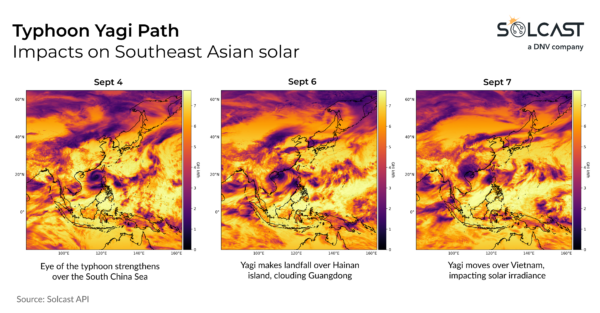Typhoon Yagi has caused a notable drop in solar production across Southeast Asia, according to analysis using the Solcast API. The powerful Category 5 storm brought extreme weather conditions to the region, plunging irradiance levels far below climatological averages.
Solar production across key cities in Vietnam, China, and the Philippines dropped significantly, with some areas reporting their lowest irradiance days on record for September. The event underscores the impact of severe weather patterns on solar generation, particularly in a region vulnerable to tropical cyclones.

Solcast data shows that large cities in the path of the tropical cyclone, like Hanoi, Shenzhen and Manila, were heavily affected by Typhoon Yagi’s thick cloud cover and intense rainfall. Irradiance in these locations was drastically reduced compared to average September
conditions, leading to unprecedented drops in solar output.
In the Philippines, the island of Luzon already endured record precipitation from the southwest monsoon early in September. Typhoon Yagi added further disruption, bringing even more rainfall and extending the period of low solar production. This has compounded
challenges for solar assets across the region, as both cloud cover and heavy rainfall suppress generation potential.

In addition to its impact on solar production, Typhoon Yagi has wreaked widespread destruction across Southeast Asia. Yagi is the first Category 5 typhoon of this season, and one of the strongest to hit the region in decades. Category 5 storms are rare in Southeast Asia, and Yagi’s track, which took it into northern Vietnam, is particularly unusual.

Most typhoons typically veer further east, but Yagi's western path brought devastation to countries including the Philippines, Vietnam, southern China, Laos, Thailand, and Myanmar. In Vietnam, the aftermath was especially severe, with days of relentless rain following the
typhoon’s landfall, exacerbating flooding and further reducing solar output.
Solcast produces these figures by tracking clouds and aerosols at 1-2km resolution globally, using satellite data and proprietary AI/ML algorithms. This data is used to drive irradiance models, enabling Solcast to calculate irradiance at high resolution, with typical bias of less than 2%, and also cloud-tracking forecasts. This data is used by more than 300 companies managing over 150GW of solar assets globally.
The views and opinions expressed in this article are the author’s own, and do not necessarily reflect those held by pv magazine.
This content is protected by copyright and may not be reused. If you want to cooperate with us and would like to reuse some of our content, please contact: editors@pv-magazine.com.



By submitting this form you agree to pv magazine using your data for the purposes of publishing your comment.
Your personal data will only be disclosed or otherwise transmitted to third parties for the purposes of spam filtering or if this is necessary for technical maintenance of the website. Any other transfer to third parties will not take place unless this is justified on the basis of applicable data protection regulations or if pv magazine is legally obliged to do so.
You may revoke this consent at any time with effect for the future, in which case your personal data will be deleted immediately. Otherwise, your data will be deleted if pv magazine has processed your request or the purpose of data storage is fulfilled.
Further information on data privacy can be found in our Data Protection Policy.